Del and Mladen review ‘The Arbors’
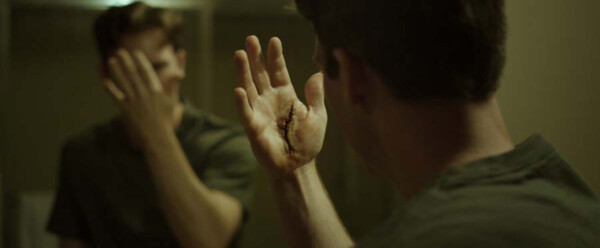
Image courtesy of The Arbors Production with The Red Arrow Studios Company.
“The Arbors” Starring Drew Matthews, Ryan Davenport, Sarah Cochrane and Alexandra Rose. Directed by Clayton Witmer. 1 hour, 59 minutes. Unrated. Streaming on Amazon Prime, Tubi TV.
Del’s take
Ethan Duanes (Drew Matthews) has a problem.
His problem is life.
Ethan is a locksmith but he cannot unlock the secret to happiness. All he can do is remember an earlier time when his parents were still alive and his younger brother a constant companion. The world seemed better then.
Now, the world isn’t better. His parents have passed away and his brother, Shane (Ryan Davenport), has started a family. The ancestral home, like Ethan, is slowly succumbing to rot and ruin, and the future seems as dark as the night shifts Ethan works.
One night, as Ethan is driving back to his rented house after a call, he comes across a dead deer in the road. He notices something moving inside the deer, a kind of insect or arachnid. He takes the carcass home, builds a container to hold the strange creature and lures it inside with cuts of meat. Then, he proceeds to care for it.
Until the creature breaks out. And people in the community begin to die.
That is the premise of “The Arbors,” a “monster movie” that isn’t a “monster movie.” It is less about things that go bump in the night as things that go bump in the heart.
“The Arbors” earns high marks for its layers and its obvious pathos. Ethan is a sympathetic loser to whom many people can relate: He is overwhelmed by life, fearful of change and nostalgic for the simpler times of the past. This theme of resistance to change operates throughout the movie – Ethan says it more than once by rhetorically asking, “Can’t this all be over?” His fidelity to the past is expressed in other ways, too. He is constantly sorting through photographs of him and his brother when they were kids. He gives his brother the gift of a toy soldier from a game they played as children called Out of Time! Ethan has kept the game; his brother absent-mindedly drops the toy soldier on the floor and before movie’s end it returns to Ethan’s possession. Ethan tells his young niece, Robin (Sarah Cochrane), he hopes to purchase the family home and restore it so that he may live there again. When Shane reveals he and his wife, Lynn (Alexandra Rose) are contemplating a move out of state, Ethan becomes agitated and for once, shows strong emotion.
Where “The Arbors” fails is its glacial pacing and the infuriating passivity of its viewpoint character. Ethan doesn’t simply miss the past; he is mired in it and will never escape. He rejects chance after chance to change his circumstances, at one point avoiding a former friend who has offered to take him away from his ennui and show him the world. In truth he doesn’t want to escape, and he would draw everybody around him into the tar pit of his inertia. This slow vortex of apathy oozes over both character and audience alike, preserving the misery in a sluggish and vapid shadowbox that never answers the question “Why?”
And when the “monster” kills people who have threatened Ethan’s attempt to restore the past to the present, “The Arbors” morphs into “Donnie Darko” and the audience is left with a new batch of questions.
What’s remarkable about “The Arbors” is that it was shot in the Winston-Salem, N.C., area in 25 days on a budget of $14,000, then finished for another $11,000.
Witmer deserves kudos for trying to rise above the meager expectations of the genre, but “The Arbors” has some deficiencies that outweigh its virtues. Still, it’s not a bad movie. Just slow, with unanswered questions and motivations. I expect Witmer will do better his next time out of the gate.
I grade “The Arbors” a C+.
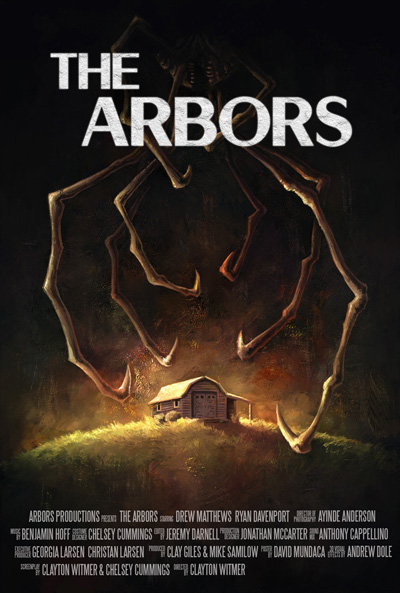
Mladen’s take
Through much of “The Arbors” I kept telling myself, “Wow, the kid playing the principal misfit really looks like a young Dennis Quaid.”
That’s how I managed to stay entertained when “The Arbors” got batty or the story cryptic or incoherent, which wasn’t all the time. Just much of the time.
Del blew a lot of words summing the plot. I’ll do it for you with one, short sentence: Rogue nostalgia is a deadly when you’re connected to person-sized spider with a mammal-like mouth packing white shark teeth.
One of my biggest problems with the movie is that I have no idea how or why Ethan and pseudo-spider are telepathically linked. If I was the angry wayward mutant arachnid, I’d be pissed at Ethan for putting me in a cage when I was but a maggot or whatever. That would be reason enough to eat his eyeballs rather than serve as an executioner for the human.
And, who the hell where those guys in the white hazmat suits? And, why didn’t at least one of them have a gun for self-defense because they were chasing an aberration of nature?
I don’t mind that “The Arbors” portrays itself as horror but is really about shitty, navel-gazing stuff like hurt feelings. People, after all, are more frightening than zombie werewolves with rabies waving Trump is My President flags. But, at times, I felt like I was watching, I don’t know, “Kramer v. Kramer” or “Steel Magnolias.”
The problem is that the film seems to want to get good and then backs off. A scene of driving at night might be too long. Or there’s the crappy voice acting when Ethan is talking to someone on his flip phone. Yes, director, I get it that Ethan is stuck in a time that no longer exists. And, why the fuck does “Connie” care about Ethan? She didn’t even sign his high school yearbook. What proof is there that she let him feel her up when they were teenagers or that they went to prom together? She materializes, tries to get him to leave town, and then de-materializes.
On the plus side, “The Arbors” provides a holistic moodiness as the backdrop of life in an unnamed town somewhere in the foothills of the Appalachians. Everything seems afflicted by Ethan’s desperate unhappiness. I liked the score. It meshed nicely with the moodiness.
The movie gets a C- because it failed to meet its promise to me like life failed to meet its promise to Ethan. It didn’t allow him to stay 13 years old forever. And, the film failed to create a sympathetic, lonely man with control of a monster who I could like.
Mladen Rudman is a former journalist and technical writer. Del Stone Jr. is a former journalist and author.
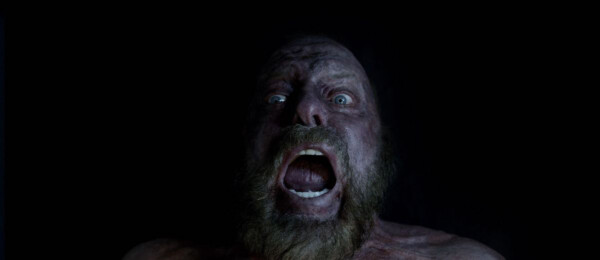
Image courtesy of Netflix.
“The Block Island Sound” Starring Chris Sheffield, Michaela McManus, Matilda Lawler, Neville Archambault, and others. Directed by Kevin McManus and Matthew McManus. 99 minutes. Unrated. Netflix.
Mladen’s take
Del warned me to avoid spoilers when I recapitulate the plot of “The Block Island Sound” because the film relies on keeping the source of the troubles endured by our protagonists secret.
So, here are a couple of sayings to help you meander through this review while I try to explain what the sci-fi-like, horror-ish “The Block Island Sound” is about without giving away the neat ending. To appreciate the ending, by the way, be sure to pay attention to the beginning of the movie. It’s the scene between mother and daughter talking about studying animals.
I’m borrowing the first indirect explanation of “The Block Island Sound” storyline from a couple of Star Trek movies: “The needs of the many outweigh the needs of the few.” I believe that’s a Spockism.
Then there’s “What’s good for the goose is good for the gander.” I have no idea where that saying originated.
The movie also portrays and warns about doing onto others, in this case marine fish, what you wouldn’t want done unto you. That truism is derived from the Bible or some other piece of historical fiction.
“The Block Island Sound” is a slo-mo film that constantly has the viewer wondering what the hell is going on. By slo-mo I mean action is limited and the story unfolds through the tension of a family that doesn’t get along. There are a couple of drunkards, the father and the son; a smart and altruistic sister and her cute daughter; an unempathetic and punitive sister; and a dead mother.
Other characters in the film are the gossip and law enforcement attitudes of a small, somewhat isolated community. A kook expounding all sorts of conspiracies about the Government, parasites, and I can’t recall what else is in the movie, too.
Semi-mass dyings of fish and birds and an apparition are also parts of the story.
“The Block Island Sound” takes place in the American Northeast, somewhere in the vicinity of Nantucket. The sea is blue-gray, as is the sky. The movie’s moodiness is similar to “The Vast of Night” or “Cosmos.”
The acting is good, even if the smart sister seems to be dumb occasionally though she’s a scientist. Chris Sheffield, playing emotionally tortured Harry, executes again and again some one of the finest examples of walking catatonia, the vacant stare and slackened face, the blank expression, a hypnotic state, describe it as you wish, I’ve seen in a movie.
Be patient watching “The Block Island Sound.” Everything is tied together at the end in pretty cool fashion. Disregard, to some degree, the family dysfunction that’s regurgitated throughout the film. It annoyed me, but I hung on until the credits rolled to see what caused the strangeness on the island and its local waters.
“The Block Island Sound” earns a B, just scraping past a B-, from me.

Del’s take
I won’t be as charitable as Mladen in grading “The Block Island Sound.” The movie was a tad schizophrenic for my tastes.
To amplify Mladen’s plot summary, the story is about a man caring for his Alzheimer’s-stricken father at the ancestral home on an island somewhere in the Northeast. His sister, who works for the Environmental Protection Agency, returns to the island with her daughter to study a series of bird and fish kills. When the father turns up missing and then deceased, another daughter, the bitchier of the two sisters, joins her siblings for the funeral. The brother resents his sisters for abandoning him to the care of their father. And now he’s seeing things. He’s drinking heavily. He’s falling apart.
For the most part the movie is competently made, and casting and script are fine (faint praise). My gripe is with the metastory. There are two stories at work here, and the McManus brothers do a much better job of telling one. The second story is not original in content or presentation.
Most interesting is the interaction between the siblings, all finely drawn by the actors. Sheffield does a good job as Harry, the suffering son who has remained behind to take care of his dementia-addled father while his two sisters pursue their lives unencumbered by familial obligations. McManus and Heidi Niedermeyer are equally effective as the two sisters who have left their ailing father in the hands of their brother, then snottily fault him for crumbling under the pressure of caregiving. The interplay between these three is sufficiently interesting to compel a watch, despite the fact that none of them is very likeable.
And the second story? It emerges slowly over the course of the action, until sometime in the second act when the climax is telegraphed, resulting in an anti-climax to wrap that branch of the narrative and the movie itself.
As many character studies go, the pacing of “The Block Island Sound” is slow, abetted by a depressing color palette of grays and steely blues, always cloudy skies, and a choppy Atlantic Ocean that does not give up its secrets. Likewise the tone is dark and funereal. You are watching the dissolution of a family as much as a mystery about dying fish and crows flying into windshields.
My sense is the overarching thematic imperative is one of loss – loss of soul due to the escalating infirmity of cognitive decline, loss of life on the part of those in the caregiver role, loss of empathy for those who have shirked their responsibilities and in the end, loss of humanity.
That’s a lot to digest in a movie that’s pitched in its trailer as being about something more congruent with a horror movie. Who wants to be entertained by grim reality when there’s a fun universe of exploding heads to be explored?
If the McManus brothers had left out the fish kills, bird kills and all the nonsense that followed, “The Block Island Sound” would have earned a B+ from me. As it is, the movie gets a C.
Mladen Rudman is a former journalist and technical writer. Del Stone Jr. is a former journalist and author.
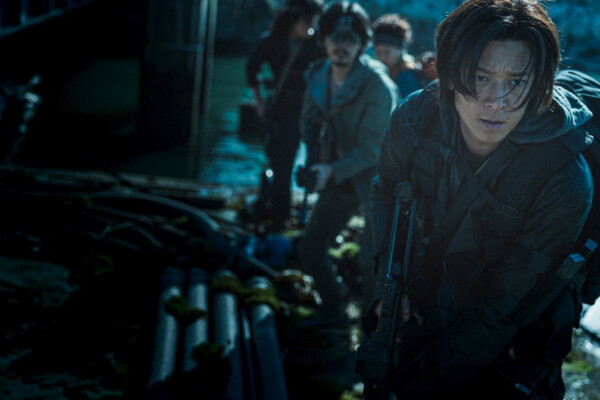
Image courtesy of Next Entertainment World.
“Train to Busan Presents: Peninsula.” Starring Lee Jung-hyun, Dong-won Gang, Re Lee, Ye-won Lee, Hae-hyo Kwon, Kyo-hwan Koo, and others. Directed by Sang-ho Yeon. 115 minutes. Rated PG-13. Amazon pay-to-stream
Mladen’s take
There I sat, wavering. It was about three-fifths of the way through the South Korean movie “Train to Busan Presents: Peninsula.” My qualms included a meditation on the film’s weird title, which was clearly an example of success exploitation marketing. Was this semi-sequel to the excellent film “Train to Busan” worthy of a good grade or does it deserve a bad grade? And, then, came the straight-faced line: “Let’s get Mom.” Poof, I dropped into the “Better than Average” column, but only just.
Before I sum the plot, you’re owed a warning. Del the zombie-phile will praise this movie, maybe even slip it an A-. He’ll be wrong. The movie is one full grade lower, but worth watching. It cost me 55 cents to lease a 48-hour viewing window on Amazon.
Recall that “Train to Busan” introduced us to some very good action horror with an unremarkable plot very well executed. A bioengineering laboratory accidentally releases a contagion that transforms people into something akin to the rampaging quasi-dead hungry we first met in 2010’s “28 Hours Later.” In “T to B,” the story was driven by a father trying to keep his daughter alive, if I recall accurately, as the infected multiply and the state rapidly loses control of law and order. “T to B” possessed stunning special effects. The locomotive slowly motoring along while zombies clinging to the back of the machine pile on each other to make a squirming, yet flowing tail of organic debris was something else.
That “something else” was missing in “Peninsula.” The computer-generated special effects lacked believable physics of motion. The vehicles bulldozing through zombies, jumping roads, or smashing into each other seemed like Matchbox cars running the gauntlet of a plastic race course. Also, at times, “Peninsula” seemed very “Casshern”-like or “Alita: Battle Angel”-ish. The difference is that “Casshern,” a 2004 Japanese movie, and “Alita” of 2019 intentionally deployed the tinge of anime as part of the storytelling. “Peninsula,” which imagined quarantined South Korea four years after the “T to B” virus was unleashed, often portrayed dilapidated urban terrain or action scenes with the patina of a video game that had mated with anime to create an almost-cartoon. In short, the visual effects in “Peninsula” were surprisingly crappy.
Oh, the plot. A South Korean soldier loses his sister and nephew to zombie-itis, but manages to save his brother-in-law. A few years later, the pair gets sucked into returning to South Korea to retrieve a truck load of American dollars for an American gangster based in Hong Kong. If they and a couple of others succeed, they get half of $20 mil. That’s money that would get them out of the political limbo of being microbe-induced refugees. Naturally, the return to the Peninsula, get it, goes astray. Dong-won Gang, playing South Korea Army Capt. Jung Seok, gets pulled off a zombie dinner plate by feisty, hard-driving teenager Jooni, played by Re Lee, and her younger sister Ye-won Lee as Yu Jin. They flee to their hideout, where Jung meets resourceful, determined, and very pretty Min Jung. Min is played by Lee Jung-hyun. She’s the mom in “Let’s get Mom.” While Jung, Min, and the girls are good and likeable characters in the film, most of the bad guys are all pretty much clichés and fail to be unlikeable. The exception was Captain Seo, nicely portrayed by Kyo-hwan Koo as desperate and scheming to the end. He has no trouble shooting the old man and Mom to get the hell off the Peninsula.
The soundtrack in the film is good enough. There was a moment when I thought I heard a few stanzas, verses, whatever you call pieces of music, that sounded like an adventure tune in the video game “Halo.”
OK, Del, take it away with your take. Please don’t let the blubbery family scenes in “Peninsula” color your judgment as they did when you watched the last film we reviewed. We owe it to our growing readership to assess correctly the merits of a film.
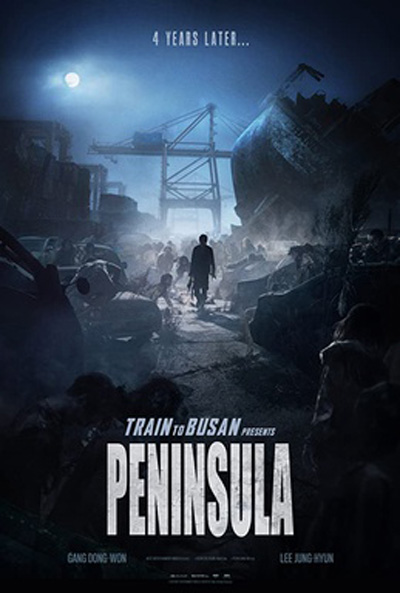
Del’s take
It was I who recommended to Mladen that we review “Peninsula.” It was not I who recommended that he tap the cooking sherry before writing his review.
He’s correct when he describes the putative prequel to “Peninsula,” “Train to Busan” as excellent. I remember foraging through Netflix one night, searching for something to watch, when I stumbled across “T to B.” Another hokey foreign zombie flick, I warned myself, before clicking the “play” button. Imagine my surprise when I discovered a modern classic in science fiction-horror, one I’ve added to my DVD collection. “T to B” is that good. I would rate it up there with the Zack Snyder remake of “Dawn of the Dead.”
So it was with great expectations that I forked over my 99 cents to watch “Peninsula.” (I’d like to know how Mladen managed to do that for 55 cents. Did he get the cooking sherry discount?)
To put it succinctly, I was not impressed. For these reasons:
1. It’s derivative. Take the premise of “28 Weeks Later,” throw in some “Escape from New York” and using crude, Frankensteined stitches graft on any road chase sequence from the “Mad Max” movies and you’ve got “Peninsula.”
2. Mladen was right about another aspect of the film – the special effects. They weren’t just bad. They were cartoonish, on par with “Speed Racer.” They completely ruined the movie for me because I’ve seen car chases and motorized mayhem done right – all that metal-crunching comprises a story of its own. You want a car chase? Consult George Miller. You don’t hand it to the CGI folks, and that’s what the creators did with “Peninsula.” Those scenes screamed “Fake!” and threw me out of the zombie-infested universe Sang-ho Yeon sought to create.
3. Many of the major characters were unlikable. As Mladen explained, the point of this group’s return to zombie-infested South Korea is to recover a truckload of American dollars. The deal is a small group will find the truck and drive it back to an Inchon dock, where it will be loaded aboard a ferry. The group gets half the $20 million and the crooks get the other half. Ahem. Of course. The crooks will most definitely abide by their end of the deal. Have you never heard of honor among thieves?
The movie is really about Gang Dong-won’s character attempting to redeem himself after refusing to help a family in need during the initial, hyper-frantic days of the zombie outbreak. As subtexts go it’s about as subtle as a Mar-a-Lago powder room and Jung-seok is such a weak and altruistic tormented-soul type that by mid-movie you’re hoping one of his putrid antagonists makes a snack of him.
4. Nitpicks. Why does a director spend a considerable chunk of screen time building tension and setting a deadline, and when that deadline arrives the director allows his characters to engage in long, deadline-busting soliloquies and dénouements?
How is it that a car will start after sitting idle four years?
Why are children always precocious and infallible?
Why are the elderly characters always expendable?
Why does a highway choked with wrecked and abandoned vehicles always have a lane open?
Why was South Korea simply abandoned? Is its net worth beneath the scope of recovery?
5. The version I saw was not subtitled. It was dubbed. Have I ever told you how much I hate dubbing? When you can see the character’s mouth moving while the dialogue track stopped three seconds ago?
Enough fussing. Bottom line: I was hoping for a movie that matched the off-the-rail entertainment punch of “Train to Busan” and what I got for my 99 cents (Really, Mladen? Fifty-five cents?) was something altogether different and, dare I say, less everything. I could wax all movie-review poetic and talk about the film’s emotional core or its resonance to the genre template but this is not a thirst trap for pretty words. Suffice it to say “Peninsula” was a disappointment.
For much better fare about the undead try “Cargo” or the unbelievably good series “Black Summer,” both on Netflix at no extra charge. For an even weirder take on the zombie genre try Arnold Schwarzenegger in “Maggie,” which you can find in some DVD bargain bins.
“Peninsula” gets a grade of C from me.
Mladen Rudman is a former journalist and technical writer. Del Stone Jr. is a former journalist and author.
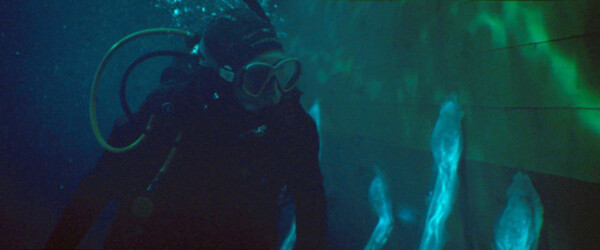
Image courtesy of Signature Entertainment.
“Sea Fever” Starring Hermoine Corfield, Dag Malmberg, Jack Hickey, Dougray Scott and others. Directed by Neasa Hardiman. 95 minutes. Unrated. Hulu, Vudu, Google Play, Amazon Prime, Apple TV+, YouTube.
Del’s take
Oh goodie. Let’s distract ourselves from the pandemic by watching a movie about a pandemic.
Not a pandemic per se but a parasitic infection that threatens to wipe out the crew of an Irish fishing trawler plying the chilly waters of the North Atlantic. That’s the gist of “Sea Fever,” a pretty good little monster movie from director Neasa Hardiman. If films speak to the times, “Sea Fever” is the voice of our COVID-19 consciousness, transposing our empty streets and restaurants with the vacant horizon of the open ocean.
The plot is familiar to fans of “Alien,” “The Thing” and even “The Shining.” Lonely, friendless PhD student Siobhán (Hermoine Corfield) has booked passage on the Niamh Cinn Óir, a rust bucket Irish fishing trawler, to study the behavior patterns of aquatic fauna. The Niamh Cinn Óir is owned and operated by the husband-and-wife team of Gerard (Dougray Scott) and Freya (Connie Nielson); and a crew of four others. Life has not been grand for Gerard and Freya, and they need a good haul this trip or they’ll lose the trawler.
On the trip out they detect a large mass of fish which unfortunately lies within a government-declared exclusion zone. It would be a terrible thing if they accidentally drifted into that exclusion zone and caught a hold full of mackerel, thus saving the Niamh Cinn Óir from receivership and preserving the crew’s livelihoods. Well gosh darn it, guess what happens.
Sometimes exclusion zones exist for more reasons than bureaucratic capriciousness, especially in movies that isolate a small group of people and pits them against a seemingly unbeatable antagonist. It is at this point “Sea Fever” becomes a metaphor for the COVID-19 pandemic as the fishing trawler crew battles a weird aquatic parasite that threatens to kill them all.
But “Sea Fever” operates on a second level, one that addresses the pandemic of loneliness that has infected the world since the invention of digital technology. On her first field study, Siobhán is forced to step out of her reclusive shell and interact, if not befriend, the crew, especially after they discover she’s a redhead (apparently redheads are considered bad luck among Irish fishermen). As the movie progresses along its somewhat predictable trajectory, Siobhán becomes more and more human as her environment descends into science fiction nightmare.
Somehow indie directors always manage to find strong actors to fill their roles and “Sea Fever” is no exception. All the performances are very good but my favorite was Olwen Fouéré as Ciara, the boat’s cook, who carried herself with a chafing blue collar dignity that seemed to perfectly capture the soul of the part. Another strong performance was delivered by Ardalan Esmaili as the boat’s principled and skillful engineer. Weakest was Dougray Scott, whose character hovered somewhere between effective leader and simpering cad. He seemed incapable of communicating the moral ambivalence of a man caught between financial necessity and obeyance of the law.
My gripes with “Sea Fever” are that it wraps up with an anticlimax that feels rushed and out of character for protagonist Siobhán, and the crew’s attempts to resolve their problem seem truncated and drama-less. What would Ellen Ripley have done had she been aboard the Niamh Cinn Óir? That might have elevated the tension considerably.
Still, “Sea Fever” is, as I said, a pretty good little monster movie and your time will not have been wasted, if monster movies are your bag. As American movies become more and more templated by the MBAs working in Hollywood these days, it’s nice to see a movie that still has character and a beating heart.
I grade “Sea Fever” a B or maybe even a B+.
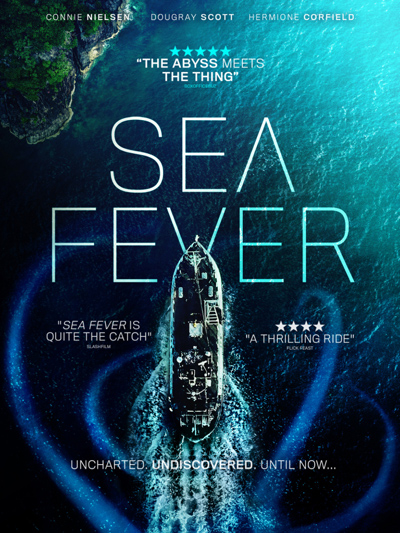
Mladen’s take
Desperation. Superstition. Science. And, a cnidarian. Say it with me, “cnidarian.” I adore that word. It wasn’t in my plain old lexicon of the English language. I had to look it up in my Oxford Dictionary of Science. Cnidarian. Cnidaria is a phylum of aquatic invertebrates that includes hydra, jellyfish, sea anemones, and coral, by the way.
In “Sea Fever,” the crew of the fishing vessel Niamh Cinn Óir become the victims of a cnidarian unknown to humanity. First, the oversized spineless predator whose centrally placed orifice is both mouth and anus, attacks their boat and then it attacks them with its eye-eating larvae.
Where Del sees a SARS-COV-2 angle to “Sea Fever,” I see a straight-up Nature will always kick Man’s ass statement in the film. Humanity believes it controls the planet. The planet disagrees. That disagreement takes many shapes. Climate change. Water shortages. Invasive species. A snowstorm in Texas that has Tumbleweed Cruz abandoning the state he represents in the U.S. Senate to flee to warm and socialist Mexico.
Though the encounter with the cnidarian drives the plot of “Sea Fever,” the story is also about society-induced desperation. The boat owner, who’s married to the captain, has to land a good catch to earn euros to keep the vessel. With that thought plaguing the couple, the captain takes a risk and then the boat owner takes a risk. Both prove fateful.
There is superstition aboard Niamh Cinn Óir. Marine biologist Siobhán, on the boat to conduct field research that her PhD advisor ordered her to do, has red hair, which, as Del points out, the crew consider bad luck. But, there’s also the superstition of religion. There is prayer for a safe journey. There is prayer for a good haul of fish. There are prayers for the dearly departed. And there’s the belief that God will yet protect the crew.
There is science aboard the boat. Siobhán, applying her knowledge, figures out enough about the big cnidarian to give the crew somewhat of a fighting chance to live.
But, in the end, neither God nor science are much help. What mattered was one person sacrificing for another.
“Sea Fever,” as Del claims, is a pretty good little monster movie. I would amend that observation with, “pretty good little sci-fi monster movie.” Though not laden with science, the movie has moments of science-y jargon – “cnidarian” for example – and “bioluminescence” and “holopalegic” and a portable, computer-powered microscope, and talk of water filtration system design. There was the hypothesis that the cnidarian normally parasitizes whales (the fishing boat was in an exclusion zone that existed to protect cetaceans and their calves) and might have mistook the passing shadow of the vessel as a sign of its normal prey.
Between trying to stay alive while a gelatinous, tentacled predator treats them as a larder for its babies and keeping themselves from going berserk under the pressure of looming infection, the crew has to struggle with a bigger question. Is it ethical to return to port when some, if not all, of the crew are nurseries for a novel parasite that could, or is it would, infect landlubbers? Poof, see you later, humanity.
The problem with “Sea Fever” is that it added baggage that didn’t need to be in the film. Too much time was used to set up Siobhán as a loner and it was unconvincing. Del mentioned that the cook carried herself “with a chafing blue collar dignity.” Chafing she was, but it was me who got chafed. The cook went from a semi-pleasant grandmotherly type to an old crone who wanted to kill my beloved Siobhán. What would be the point of killing the one person who had the technical know-how to help people stay alive?
Regrettably, I find myself in the unforgivable situation of agreeing with Del. “Sea Fever” is a B. But for a couple of tweaks, including more encounters with momma cnidarian, this movie would have easily catapulted to an A.
Mladen Rudman is a former journalist and technical writer. Del Stone Jr. is a former journalist and author.
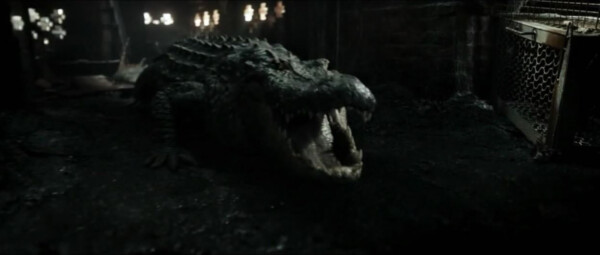
Image courtesy of Paramount Home Entertainment.
“Crawl” starring Kaya Scodelario, Barry Pepper, Morfydd Clark. Directed by Alexandre Aja. 127 minutes. R rated.
Mladen’ take
The film “Crawl” is a model of efficiency and efficacy. In the first, oh, 10 minutes, the audience is introduced to the fact that our heroine Haley is a good swimmer who wants to be gooder; that there’s tension in her family; that a powerful hurricane changed course unexpectedly and is heading for South-ish Florida; that first responders will be unable to help if you’re stranded; that Dad isn’t answering calls or texts; and that the family’s dog faces peril. Hell, even the film’s title is efficient because much of the action takes place in a “Crawl” space beneath a home “Crawl”ing with particularly vicious alligators.
“Crawl” has been graded by IMDB viewers as a mediocre horror movie. They’re wrong. This film is an A-, though it misfires here and there. For example, the first couple of gators to attack Dad and Haley hiss, which is OK, and grumble‑moan like they have larynxes. During courtship, bull gators do generate low-frequency sonic vibrations through the water to show-off their manliness to breed and designate territory. But, in “Crawl”, the gator sonics happen in a largely dry, for the moment, “Crawl” space when, I imagine, the gators were thinking about something other than mating. Don’t misunderstand. The gator grumble‑moans were nothing like the shark in “JAWS IV” (or was that “V”?), breaching and then roaring. Still, making the gators make intimidating noise to add menace to the movie was a tad contrived. Also, the film’s depicted family strife is unneeded and the occasional pep talk from Dad for his daughter Haley’s benefit when her tenacity, spirit, resourcefulness, guts, or hope flag amid heavy rainfall, a flooding house, and death‑by‑gator of a childhood friend languorous. And, yes, there’s the questionable decision to leave the house after Haley and Dad finally escape from the reptile‑infested “Crawl” space to reach a boat by wading a couple of hundred feet through murky, hip-high water.
The boat, by the way, was parked at an inundated gas station and convenience store. It was to be used as the escape vehicle by three people who wanted to steal the store’s ATM. Can you guess what happens to the robbers? The fate of the trio is an example of the many times that “Crawl” excels as creature feature horror.
Del will complain about the jump-out-of-your-seat moments in this movie, but I loved the hell out of them. The gator busting through a staircase. The lightning bolt that illuminates a big‑ass meat eater, jaw agape, behind Haley. And, there’s suspense. Lots and lots of suspense. Reaching from a somewhat safe perch across flood water strewn with floating debris that obstructs your view to get your dead friend’s Glock – he was a sheriff’s deputy – for protection. The dog swimming through a long, darkened hallway to reach Dad. All delightful.
“Crawl” also provides a solid dose of gore. Water turning red as gators bite and thrash their human prey. A death roll. A gator gripping Dad near the elbow, snapping his arm in half and then tearing it off. Floating corpses. Wait to you see how Haley dispatches a gator that has taken hold of her. Dad, too, before losing his arm later in the movie, whacks a gator after trapping it in a clever way.
Sit back, if you can, and enjoy “Crawl”. It’s a masterful little film with likeable characters facing cold‑blooded, almost plausible, threats.
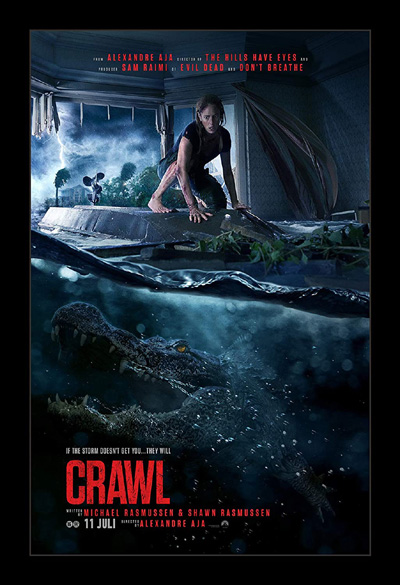
Del’s take
“Crawl” is a two-hour and seven-minute wet T-shirt contest, which explains why Mladen likes it so much.
Me? I can take it or leave it. I have nothing against standard-issue potboilers, even if they’re shameless cash grabs, in this case by the studio and a slumming Barry Pepper, who usually chooses more artistically meritorious projects. But schlock is like Hooters chicken wings – to enjoy them one must be in the mood for them, assuming one can focus on the wings and not the breasts. Maybe I wasn’t in the mood for a serving of grease delivered by a perky coed.
As Mladen explained, the protagonist, Haley, travels two hours south of Gainesville to look for her dad as a cat five hurricane approaches. Dad isn’t answering his phone and Haley’s sister up north fears the worst. Haley and Dad are especially close; she’s a college swimmer and he was her coach throughout her youth. But now she’s having doubts after losing a relay, and somehow that means Dad is a monster, or something like that. You know … something conflicty.
As she treks to the AWOL Dad’s seaside abode she passes a flooded alligator farm. These are the Special Super Intelligent Mind-Reading Alligators from Mars or something based on what happens later in the movie. She finds Dad in the crawl space beneath his house, clawed to damn near bloody ruin by … well, OK. I should let you watch the movie to find out, but, Psssttt! It crawls.
What follows is a string of predictable pitfalls, emotional ups and downs and cliché after soggy, growly cliché. I will give “Crawl” credit – in most of these movies the protagonist is a crack shot who always dodges the falling asteroid and ambles into the sunset with the girl – or boy – slung over his or her shoulder. In “Crawl,” no such immunity is granted, and since it’s a father and daughter there will be no ambling into the sunset. Well, maybe an AARP lecture or two.
No, Mladen, I didn’t object to the jump scares. What I did object to was the stupidity – like helicopters flying in a cat five hurricane. Like people strolling the flooded streets in a cat five hurricane. Like a one-armed guy able to bludgeon his way through a roof with his bare hand.
If you go into “Crawl” with sufficiently low expectations you’ll enjoy it, because it’s a decently entertaining movie with not bad special effects. But that’s all we’re talking here – entertainment. Not art.
I give it between a B- and a C+. Make it a B- because the hurricane actually looked somewhat realistic (although heads up, moviemakers: We just had a cat five here in the Panhandle and there’s tons of footage on YouTube if you’d care to educate yourself about what a storm like that looks like).
Mladen Rudman is a former journalist and technical writer. Del Stone Jr. is a former journalist and author.

Image courtesy of Benaroya Pictures.
“Haunting on Fraternity Row” starring Jacob Artist, Jayson Blair and Shanley Caswell. Directed by Brant Sersen. 99 minutes. Rated TV-MA.
Del’s take
There’s no explaining my Netflix whims, but they have introduced me to surprisingly good films (“Troll Hunter, “Birdbox”) and some real stinkers ( “Open House,” “IO”).
Then there’s that gray area between, where movies that are neither good nor awful fall. “Haunting on Fraternity Row” fits that realm. You can’t expect much from a movie with the word “fraternity” in its title and “Haunting” doesn’t provide much. It’s a frat party punch bowl of clichéd characters and their predicaments that you have seen a thousand times before minus these silly details.
The story is about a group of frathouse seniors on the day of their last big bash before graduation, the annual Luau Party. They want this to be a party for the ages because although it’s never said, they seem to collectively understand their time together is soon to end and they don’t want these days to be forgotten (although they will). So the boys are busy abusing pledges, stocking the shelves with booze and kegs, setting up Hawaiian-themed decorations and flirting with sorority cleaning girls.
Speaking of kegs, the hapless pledges drop one down the basement stairs and it punches a hole through a wall, revealing a tunnel that opens into a scary room with scores of light fixtures. One of the boys refers to it as a place where “you can’t see your shadow.” Oooh-weeee-ooooh.
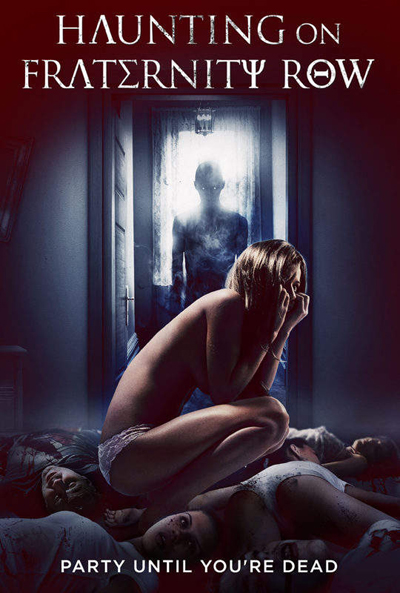
The room is quickly forgotten as party time approaches. Tiki torches are lit. Sand is poured for the “beach.” A slaughtered pig makes its way to the roaster. And did I mention booze? Oceans of booze – the entire output of a brewery and a distillery – is laid out in astonishing plentitude. It’s like Golden Corral buffet for alcoholics.
Frat brother Dougie (Ashton Moio), meanwhile, has been researching the house’s past and learns that a terrible event took place here decades ago – the owner at that time invited a group of people to dinner and slaughtered them. Dougie thinks the creepy room may have some larger significance than a room where a person can’t see his shadow.
The party commences, with all the alcohol-fueled, sex-starved antics you know to expect from countless movies about frat boys and the sorority girls who love them – until all hell breaks loose, and I mean literally breaks loose. Objects move, mysterious growls emanate from the shadows, and people start dying, their eyes seemingly burned from the sockets.
I won’t tell you what happens afterwards should you decide to throw away an hour and a half of your life on this movie. Suffice it to say “Haunting” has more vices than virtues. It is sometimes amusing (but not often enough), sometimes spooky, and it might just remind you of a college experience or two (not me – I commuted).
Notice that damning with faint praise? That’s because “Haunting” is mostly a hastily assembled mashup of hackneyed characters doing what hackneyed characters do – except they’re doing it in a horror movie. That might work with sufficient camp (“Happy Death Day”), but the laughs are about as unlikely as any of these dimwits getting a job after graduation.
You’ve got the rich asshole and his catty sorority girlfriend, the hunk who’s dumb as a brick, the fat pledge, the nerd pledge, the smart frat who uses his powers for, well, neither good nor evil, but nothing productive either. Then you’ve got the earnest, soulful frat, Jason (Jacob Artist), and the girl he’s crushing on, Claire (Shanley Caswell). Jason is too shy to make his move but Claire is patient and awaits his stiffened courage (not what you think) while the other boys rollick in the receding tide of hormonal sex addiction (they are about to graduate from college, after all). Will Jason and Claire hook up? Will Dougie get to the bottom of the frathouse murder mystery?
And who’s going to clean up this mess?
I didn’t much care for “Haunting.” Characters are thinly sketched. The house’s backstory is barely touched. A motivation for the “haunting” is absent. Director Sersen seems to care more about scenes of college debauchery and raunchy dialogue than telling a decent ghost story.
It’s all very cursory and sketchy. I wasn’t scared because I didn’t care about anybody. You won’t either.
For a sparse moment of fun check out “Haunting on Fraternity Row.” I caught it on Netflix, where all it cost me was 99 minutes of boredom.
Grade D+.
Del Stone Jr. is a former journalist and author.
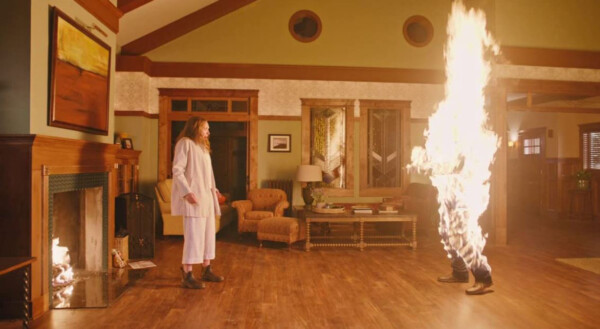
Image courtesy of A24.
“Hereditary” Starring Toni Collette, Gabriel Byrne, Alex Wolf and Milly Shapiro. Directed by Ari Aster. 127 minutes. Rated R.
Del’s take
“Kinda boring, isn’t it?” said the woman in the hallway as I headed for the men’s room. She had seen me coming out of the theater where “Hereditary” was about halfway through its 4:20 showing.
“It’s so very slow,” she continued as she headed back to the theater. Seems she was on her own bathroom break. But she was only partly right.
Said to be the “scariest movie of the year so far,” “Hereditary” is not just “kinda” boring. It’s VERY boring. The first two acts are thuddingly dull, and they’re followed by a third act mashup of horror movie clichés and a reveal that will have you asking yourself, “You mean, that’s it?”
The story begins with a funeral. Annie (Collette) is burying her mom, a miserable old bitch who made Annie’s life a living hell. In fact, Annie comes from a family of whackjobs – schizoids, paranoids and suicides – and now the last one has died. But with a title like “Hereditary” you know Annie’s life will never settle down to that pleasant myth of Americana depicted in every Norman Rockwell painting.
In fact, her current family is downright weird. Husband Steve is passive to a fault, letting every member of the family use him as a doormat. Big brother Peter is a pot-smoking cipher who has no purpose in life except that of professional victim. Little Sister Charlie is a strangely sociopathic oddball with no friends, no interests and no apparent redeeming qualities.
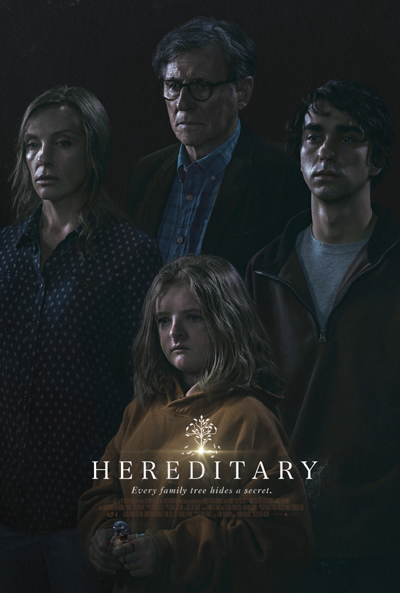
Annie herself is not exactly Mom of the Year material. She sleepwalks, at least once dousing the kids with paint thinner and trying to set them on fire. She re-creates various tragedies in her life as miniature models, an artform that has brought her a measure of acclaim, at least in the part of the world that appreciates depictions of headless children hanging out of the window of a Volvo stationwagon.
And there you have the first two acts of the movie – a slow infodump of all this boring background. The woman in the hallway almost got it right. Very boring.
I won’t tell you what happens in the third act because that would spoil it for you, God forbid you actually see this movie. But I will say this: Little girls crawling across the ceiling isn’t scary anymore. Candles suddenly spouting gouts of flame isn’t scary. Séances, furniture tipping over, flies in the attic – these things aren’t scary anymore because they’ve been done to death.
Collette is super as the besieged Annie. One scene, in which she’s having it out with her son over the dinner table, is Oscar-worthy in my opinion. And young Shapiro is nicely weird as the bird head-snipping Charlie. But Byrne and Wolff are less impressive, not through any fault of their own. Their characters are simply less impressive.
“Hereditary” isn’t scary. It lacks the tension of a good scary movie. And nothing is left to the imagination. You take a movie like “The Haunting,” “The Innocents” or even “Alien” – now THOSE are scary movies. They build their tension slowly and carefully, and they show you only hints of the Bad Thing, allowing your imagination to fill in the awful details.
If you’re in the mood for “Rosemary’s Baby” meets “The Exorcist,” by all means catch “Hereditary.” But prepare yourself for a long slog with a meager payoff. I’m pretty sure you’ll be disappointed.
I grade this movie a C.
Del Stone Jr. is a former journalist and author.
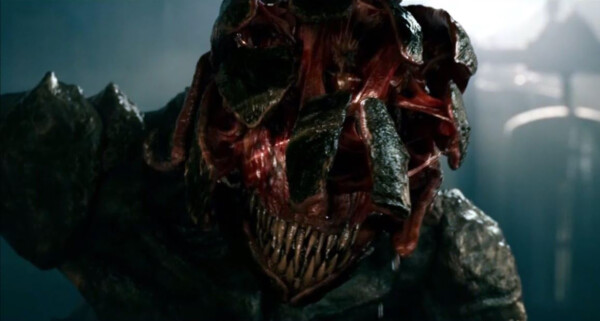
Image courtesy of Paramount.
“A Quiet Place” Starring Emily Blunt, John Krasinski, Millicent Simmonds and Noah Jupe. Directed by John Krasinski. 90 minutes. Rated PG-13.
Del’s take
“A Quiet Place” is relentlessly tense. To be honest, I was relieved when the movie ended because throughout, my stomach was cinched into a knot. It has a couple of problems, but overall it’s a good value for your entertainment dollar and I recommend it.
It’s directed by John Krasinski of “The Office” fame, but Emily Blunt, who plays his wife both on and offscreen, has been getting top billing. Krasinski also directed the film. I’ve always wondered how that works. If you screw up a scene, do you get mad and yell at yourself?
The story is about a family trying to survive the emergence of a blind super predator that hunts by sound. I was a little unclear as to where the predators came from. Are they extraterrestrials? Demons? Genetic mutations? I don’t think the movie made that clear, but reviewers are calling them aliens so I’ll go with that.
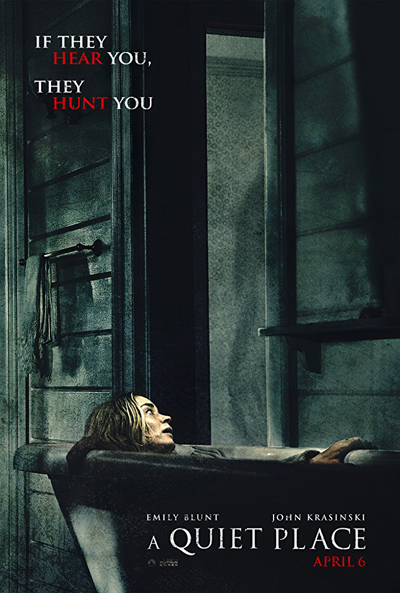
The Abbott family lives on an abandoned farm in the countryside, never speaking, never wearing shoes, never doing anything that might reveal their presence to the monsters. They communicate through sign language and scatter sand along their footpaths to muffle the sound of their tread.
The first anecdote of the movie ratchets up the tension to an unbearable level. The family is scavenging for supplies in a nearby town. Their youngest, a little boy named Beau, finds a battery-operated space shuttle toy and wants to play with it, but Krasinski takes it away from him and removes the batteries, explaining the toy is too loud. Later, Beau’s big sister Regan (Simmonds) gives him the toy, and as they’re leaving Beau grabs the batteries.
As they’re walking back to the farmhouse the boy falls behind – because he’s loading the batteries into the toy. When he turns it on it begins to emit loud sounds, and what you fear might happen … well … it actually happens.
Cut to a year later. Blunt is pregnant. Otherwise, nothing has changed. Well, not quite. Regan blames herself for her little brother’s death. She thinks her father hates her. She doesn’t feel welcome in the family, even after her dad tries to invent a turbocharged hearing aid that might repair her deafness. The Abbotts’ other son, Marcus (Jupe), is more terrified of the monsters than the rest of the family and doesn’t think his father will keep them safe. Turns out he should be afraid.
I won’t say anything more about the plot. I don’t want to spoil it for you. Suffice it to say everything that follows cranks up the tension to the point you will be breaking for the bathroom or snack bar just to get your heart back in sync, like I did during a certain scene involving a nail.
But yes, in my opinion the movie had a few problems. The story supposedly takes place between one and two years after the creatures arrive, yet the town the Abbotts raid for supplies looks like it’s been abandoned for many years. By the same token, the farm where they hide is surrounded by lovingly cultivated fields of corn, which could not have been accomplished without the use of heavy – and loud – machinery.
And what’s with this baby thing? Why would they bring a baby into this world? And aren’t babies loud? I mean, really, really loud?
If the monsters are attracted to sound, why couldn’t Krasinsky set up some speakers in the middle of that corn field, crank up the Iggy Pop and blast the monsters to smithereens when they show up?
Details, details.
Apart from those gripes, “A Quiet Place” is a super tense, super scary movie that should appeal to both fans and non-fans of horror. See it in a movie theater. Don’t wait for it to show up on Netflix or Prime.
While I’m at it, let me recommend the smartphone app MoviePass. You pay $7 a month for one theatrical release – per day. Thirty-one movies for $7? I don’t know how they make money at it, but somehow they must.
That’s how we got to see “A Quiet Place.”
I give it a B+.
Del Stone Jr. is a former journalist and author.
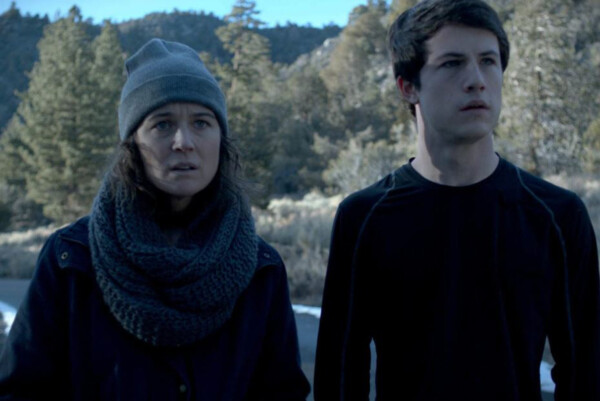
Image courtesy of Netflix.
“The Open House” Starring Dylan Minnette, Piercey Dalton and Sharif Atkins. Directed by Matt Angel and Suzanne Coote. 94 minutes. Rating not listed.
Del’s take
“The Open House” was pitched as a horror movie and I watched it because Netflix has been streaming decent non-theatrical programming lately (“Mindhunter” for instance).
Unfortunately, that isn’t the case here. While “The Open House” initially holds promise as a lite version of “The Shining,” it undergoes a slow collapse as it slides toward its dire conclusion, leaving the viewer to wonder what the point of all that was.
It’s hard to discuss the movie without spoiling it, so beware.
Suffice it to say young Logan Wallace (Minnette) is a promising track star living in what I presume to be the foothills of the Rocky Mountains – Colorado perhaps? – with his mom (Dalton) and dad (Aaron Abrams). All is not well in the Wallace household. Dad’s unemployment has stretched the family budget to the limit, and mom has tried, without success, to find a job herself. The rent is due and there’s no money to pay the bills. Meanwhile, Logan hopes to make the Olympics in track and field, something that may become possible if he continues to improve his times.
Logan and his dad venture to a convenience store for a carton of eggs and quart of milk. While Logan waits in the van, dad is mowed down in the parking lot by a driver suffering a medical event. It is all very sudden and heartbreaking, as Logan’s relationship with his father is one of the movie’s sparse warm spots. With the death, a bad situation has been rendered into a horrible situation.
After the funeral, Logan’s aunt offers to let them stay at her and her husband’s remote mountain house while they figure out what to do with their lives. Logan’s mother, aware of their dire financial straits, accepts the offer, much to Logan’s predictably selfish despair. In fact, he spends the rest of the movie pouting and blaming his mother for their sad turn of fortune.
The house is a McMansion with a spooky old basement that seems impervious to illumination. In fact, not once do Logan or his mother attempt to locate and replace a burned-out light bulb, meaning several trips into the crypt-like basement with a flashlight (and you know who temperamental flashlights are in horror movies) will be necessary after scary things start happening.
The townfolk comprise the usual suspects – the crazy, nosy neighbor; and the noble store clerk who might just have an interest in Logan’s mother (much to Logan’s irritation) and otherwise manages to show up at any number of weird, beyond-coincidental occasions, conjuring visions of stalkers.
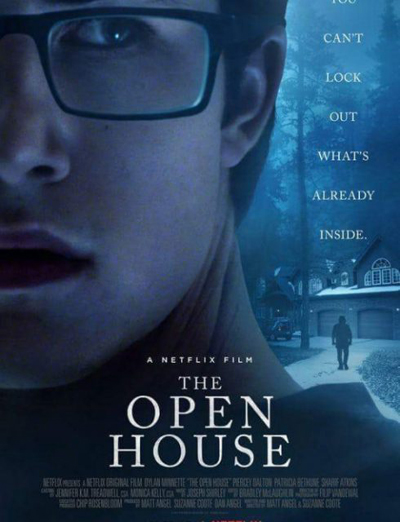
Meanwhile, weirdness escalates. The water heater keeps getting turned off. Logan’s glasses disappear, then reappear. Loud noises interrupt everybody’s sleep. Strange vehicles pull into the driveway, their headlights blinding, then abruptly leave. And nobody is looking for a job.
The house is for sale. Every Sunday between the hours of 11 a.m. and 5 p.m., Logan and his mother must leave for open house. The movie suggests that somebody, or something, arrived for one of these open houses and decided to stay.
Which is a shame, because the movie’s other tensions provide much more interesting potential – Logan having to set aside his dreams of the Olympics, the resentment he feels for his mother, and his mother’s resentment of her husband’s failure to provide for them. These are barely explored in favor of, well, dead-ends, red herrings, and an antagonist who seems to arrive from somewhere beyond the movie’s logical reach.
“The Open House” wraps with an absurd and pointlessly nihilistic series of events that remind me of films I saw in the 1970s, movies that sought to achieve emotional resonance by clubbing the viewer with cruelty and shock. That didn’t work then and it doesn’t work now.
Minnette is wooden and unsympathetic in his role as Logan, while Dalton manages to imbue her saddened wife and mother character with moments of real pathos. Both are saddled with a screenplay that, in the end, doesn’t make much sense.
It’s a nice-looking movie but I can’t recommend “The Open House.” If you subscribe to Netflix streaming and want to watch it, by all means do so. It will cost you only 94 minutes of your life.
I would grade this movie a generous C-, maybe a D+.
Del Stone Jr. is a former journalist and author.
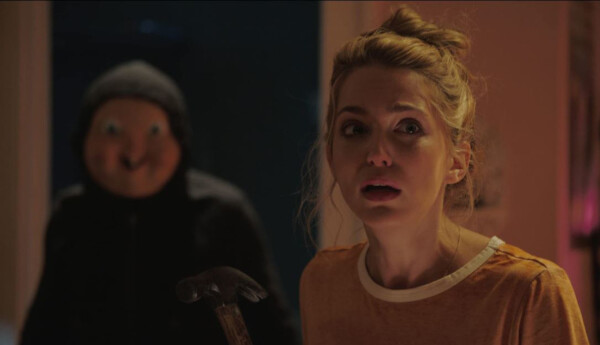
Image courtesy of Universal Pictures.
“Happy Death Day” Starring Jessica Rothe, Israel Broussard, Ruby Modine, Charles Aitken and Laura Clifton. Directed by Christopher Landon. 96 minutes. Rated PG-13.
Del’s take
I’m not going to say it … I’m not going to say it. …
Oh hell, who am I kidding? Of course I’m going to say “Groundhog Day” with a killer.
That’s the conceit of “Happy Death Day,” an entertaining trifle of a horror slash comedy (Yes!) that has come to a theater near you. Just in time for trick-or-treat, “Death Day” neither scares, edifies, nor elevates the spirit. What it does do is entertain with humor, mild romance and a who-dunnit that will defy your attempts to finger the killer.
The story goes like this: It’s Tree Gelbman’s (Rothe) birthday, but even Tree isn’t celebrating. She’s a beta beeyotch sorority snob who treats people as if they were disposable, except for her yummy college professor, Dr. Gregory Butler (Aitken), with whom she’s having an affair. She awakens in a dorm room (to her shame) with a ferocious hangover and finds she cannot remember what she did last night, especially as per young Carter Davis (Broussard) whose bed she currently inhabits. Carter is below her station in the college caste and she hustles out of his dorm lest one of her sorority sisters tumbles onto her indiscretion.
That night, on her way to a party, Tree encounters the killer, an individual wearing a pig baby mask who chases her across the campus and eventually stabs her to death. Tree jolts awake in Carter’s bed, as she did that morning, and the day begins to anew, unspooling exactly as it did before, perhaps with a change of viewpoints for the audience’s sake.
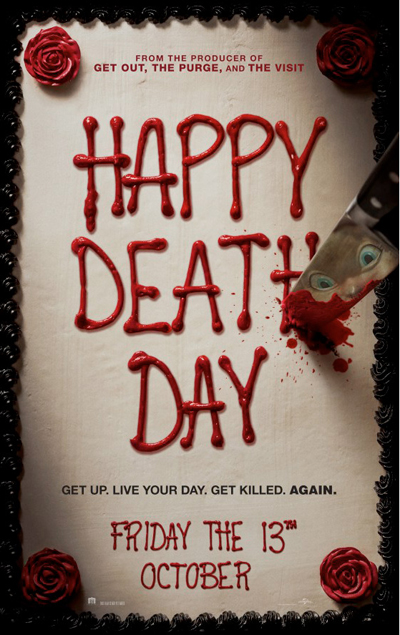
As the movie goes on we learn Tree will continue to relive the day, over and over, until the killer is dispatched. Problem is, her every attempt to kill the killer ends with her own death – by gunshot, baseball bat, hanging, bus collision, even fire. Does the obnoxious Tree deserve to live? Will she figure out a way to destroy her nemesis before dying herself?
Interestingly, each iteration of her life gives Tree a chance to see what a terrible person she has become. As the callow but earnest young Carter observes, it’s never too late to change. And change is what Tree does, so that by movie’s end you may actually like her, assuming she lives long enough for that to happen.
At roughly an hour and a half, “Death Day” is shorter than a lot of current movies such as “Blade Runner 2049,” which clocks in at almost double the length. The movie moves along at a brisk pace and you’ll be kept awake by the snappy dialogue, daily variations in Tree’s manifestations, and the puzzle over the killer’s identity (Hint: Tree is an equal opportunity snob. It could be anybody on campus.). You won’t be put off by blood because there is hardly a drop.
I was unfamiliar with the cast, but everybody turns in a creditable performance, including director Landon. “Death Day” was written by Scott Lobdell, who is primarily a comic book writer.
Somebody at Blumhouse must be licking his chops. Costing a mere $4.8 million to produce, “Death Day” has earned $40 million plus as of week 2. It will likely top out at over $50 million earning a tidy profit for the Blumhouse horror meisters. Expect it to appear on DVD and streaming in the not too distant future, joining a fraternity – or in this case sorority – of young adult-themed slasher movies that provide a forgettable hour and a half of entertainment value then recede into the cinema background.
Go see it at the movie theater, because all movies deserve to be seen on the big screen.
I give it a score of B+.
Del Stone Jr. is a former journalist and author.